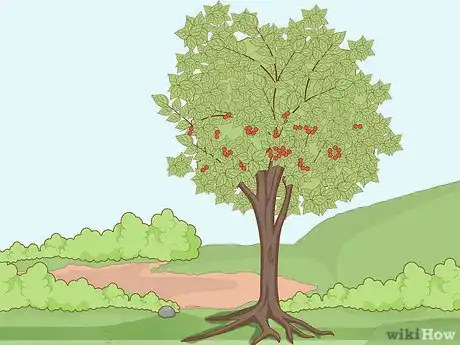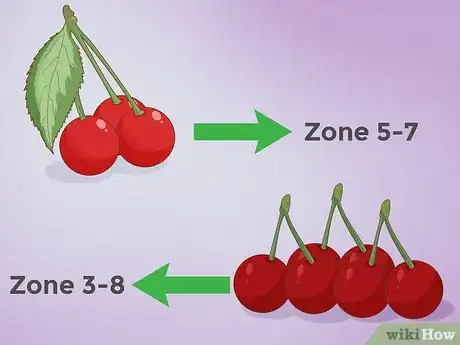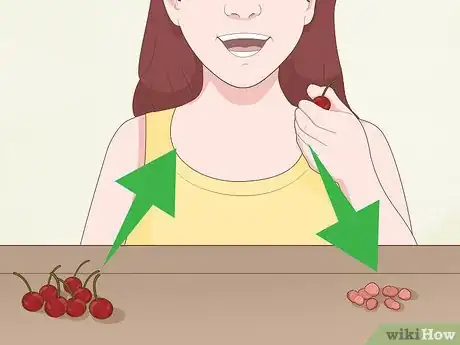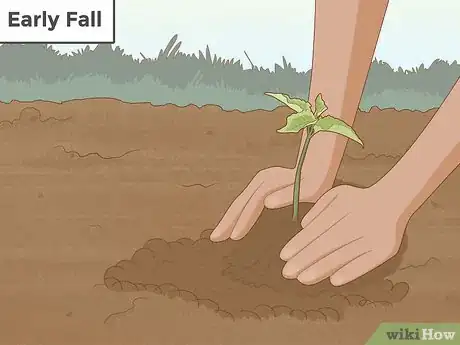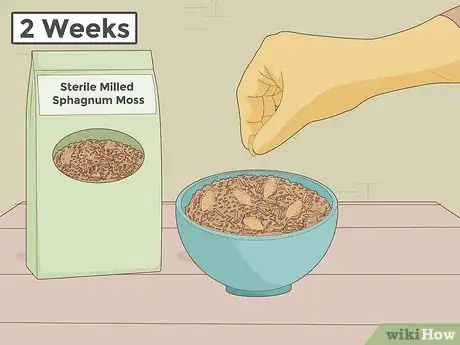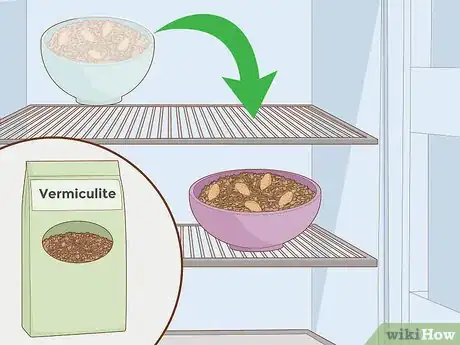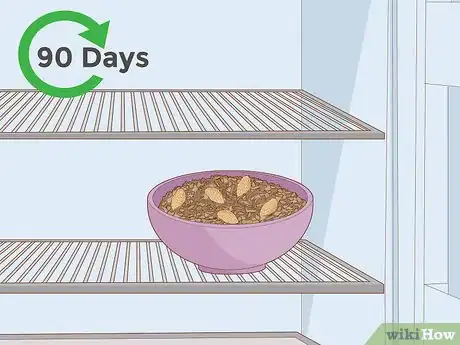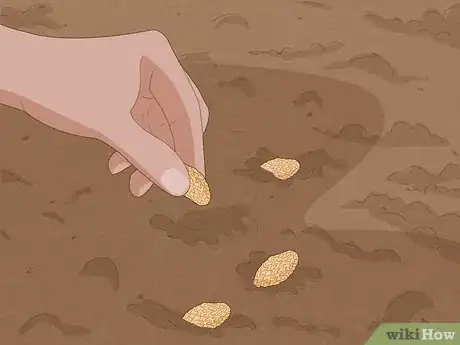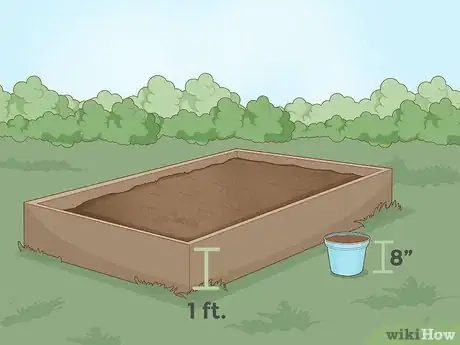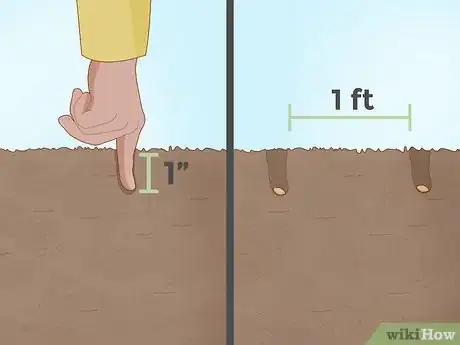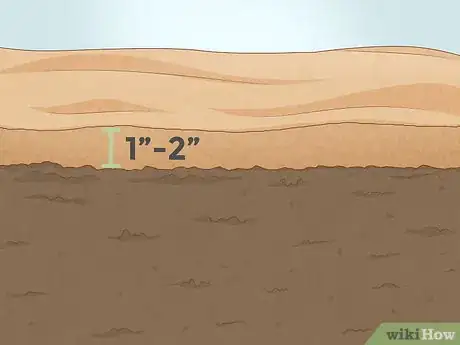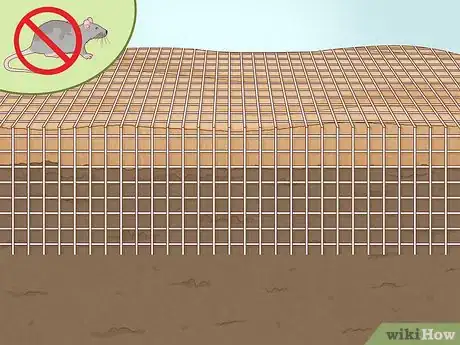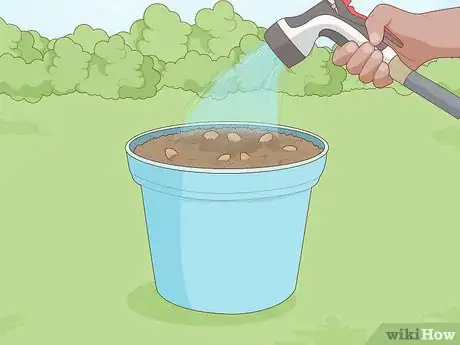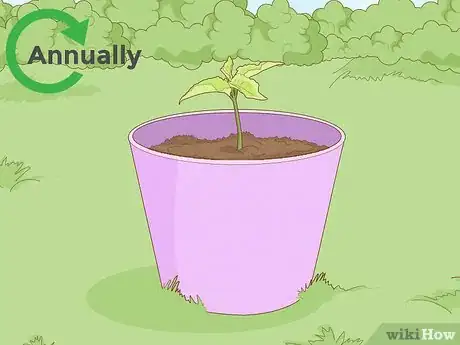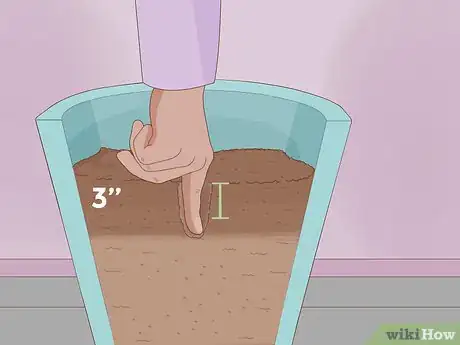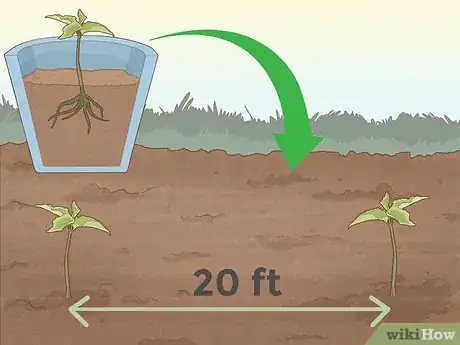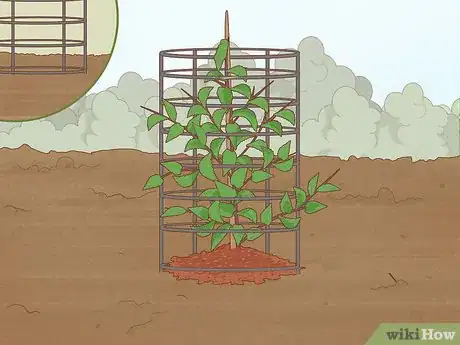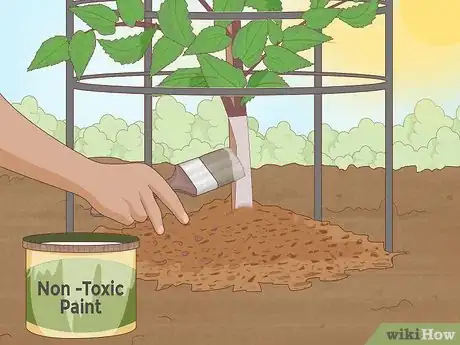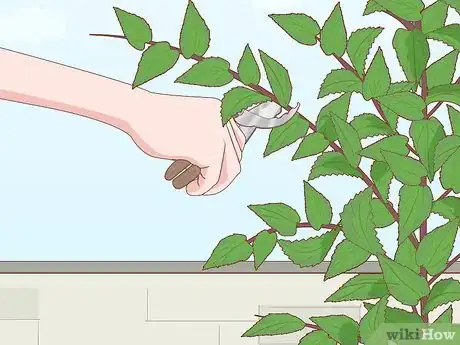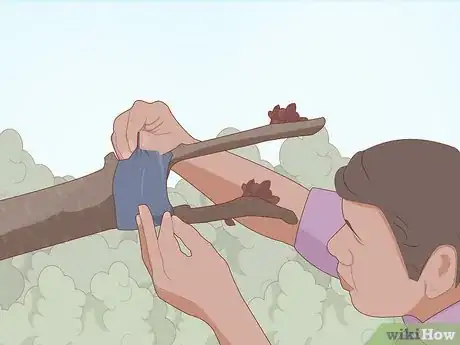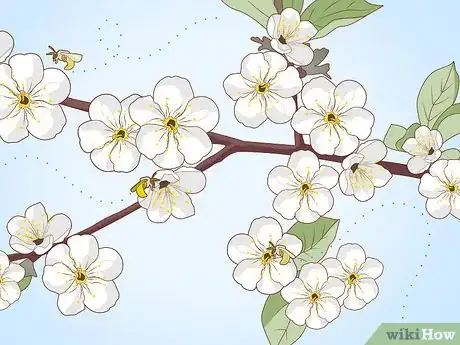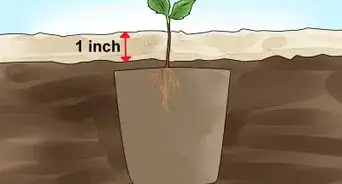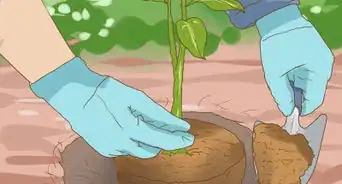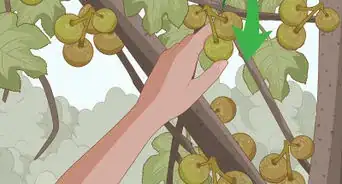This article was co-authored by Andrew Carberry, MPH. Andrew Carberry is a Food Systems Expert and the Senior Program Associate at the Wallace Centere at Winrock International in Little Rock, Arkansas. He has worked in food systems since 2008 and has experience working on farm-to-school projects, food safety programs, and working with local and state coalitions in Arkansas. He is a graduate of the College of William and Mary and holds a Masters degree in public health and nutrition from the University of Tennessee.
There are 9 references cited in this article, which can be found at the bottom of the page.
wikiHow marks an article as reader-approved once it receives enough positive feedback. This article received 14 testimonials and 87% of readers who voted found it helpful, earning it our reader-approved status.
This article has been viewed 825,617 times.
Commercial cherries are grown from grafts so the growers know exactly what they're getting. This is because planting cherries from seeds may produce bitter fruit. Planting cherry pits is a project for home growers who want to take on a challenge and who are looking for an ornamental plant. To plant cherry seeds, plant the dried pit of a cherry in well-draining, neutral soil outdoors during the early fall, choosing a spot with plenty of sun and pressing the pit 1 inch (2.5 cm) beneath the soil. You may also wish to start the cherry seed indoors, and plant them outdoors in the spring. Keep in mind that cherry trees often grow to 25 ft (7.6 m) or taller, and you can't always guarantee a bountiful harvest of fruit, so make sure you want that centerpiece in your yard!
Steps
Preparing Cherry Seeds
-
1Know what to expect. Cherries do not grow true to seed, meaning the tree won't be the same variety as its parent.[1] You might get a tree that can't survive your climate or local diseases, or that doesn't bear tasty fruit. But you might get a new and beautiful tree, and either way you'll have fun along the way.
- If you want better odds, plant a young tree instead. A local nursery can recommend a grafted plant suited to your climate and soil.
-
2Choose your cherries. Ideally, find fresh cherries from a local tree or farmer's market in mid to late summer. Early-fruiting varieties are often sterile, while grocery store fruit can work but tends to have a low success rate.[2] [3] Get a good large handful, since not all of them will sprout. There are two common species of cherry to choose from:[4]
- Almost all fresh cherries for sale are sweet cherries. These are the best for eating, but most are only hardy in USDA hardiness zones 5–7.
- Sour cherries tend to be easier to grow, and can survive in zones 3-8 depending on variety. The fresh kind can be hard to track down, so ask around at your farmer's market.
Advertisement -
3Eat the fruit. Lucky for you, the flesh of the fruit needs to go before planting. Enjoy the fruit and wipe off the last bits clinging to the seed with a damp paper towel.
- If it's still early or mid-summer, let the seeds dry on a paper towel for a couple days, then store in an airtight container in a cool spot.[5] Retrieve them in late summer and continue to the next step.
-
4Consider planting outdoors in early fall. Cherries need to experience constant damp and cold for 3–5 months in order to germinate. If you get cold winter weather about this long but don't get below -20ºF / -30ºC, you can go the easy route and plant the cherries in fall. If you decide to do this, skip down to the next section. If you don't live in this climate or you prefer a method with a higher success rate, continue to the next step instead.
- Sweet cherries do best with a couple weeks of warm weather before the cold. Planting in late summer or the very start of fall can accomplish this. However, a "warm snap" after the cold weather has started can send some cherries back into dormancy.[6] Refer to an almanac or other long-term weather prediction to avoid this.
-
5Keep sweet cherries in warm, moist sphagnum moss for two weeks (optional). Many people skip this step and still see a few cherries sprout, but this should increase the germination rate for most sweet cherries.[7] Here's how to set up this process, called warm stratification:
- Buy fresh, sterile milled sphagnum moss. This material fights off mold, which is the biggest risk at this stage. Handle moss with clean gloves to avoid introducing spores.
- Put the moss in a plastic bag or container and add room temperature water (68ºF / 20ºC).[8] Let it absorb the water for 8–10 hours, then squeeze out the extra moisture.
- Pop a few air holes in the lid. If using a plastic bag, leave it slightly open at the top.
- Add the cherry seeds and leave them there for two weeks at the same temperature. Check after the first day or two to pour out standing water, then weekly to throw out moldy seeds (if any).
-
6Transfer to cold, moist material. Next, you need to convince your indoor cherries they're going through winter. This "cold stratification" treatment is very similar to the last step, with a few details changed:
- You can use sphagnum moss again, but peat moss or a 50/50 mix of peat moss and sand may work best.[9] Vermiculite will work as well.[10]
- Add enough water to moisten the material without getting it soggy, then add seeds.
- Place in the refrigerator or other area between 33º and 41ºF (0.5 to 5ºC) (ideally at the top of this range).[11]
-
7Keep refrigerated for about 90 days. Most cherries need three months of cold treatment before they're ready to plant, and some prefer five. Check on the seeds every week or so. Pour out standing water if present, and add a little more water if the material is drying out.
- Check more often toward the end of this period. If the hard seed coats have begun to crack, plant right away or reduce the temperature to 32ºF (0ºC) until you're ready.[12]
-
8Plant in spring. As soon as the last severe spring frost passes, the cherries can go in the ground.[13] Check out the next section for detailed instructions.
- If you want to get started early, you can plant the cherries in a large indoor pot.
Planting Cherry Seeds
-
1Choose a spot with good soil. Cherries need plenty of sun and good air circulation. They prefer fertile, sandy soil with excellent drainage and neutral or slightly acidic pH.[14]
- The young tree needs room for a taproot. If planting in a container, it should be at least 8 inch (20 cm) deep.
- Cherries are very hard to grow in clay soil. If you want to make a serious attempt, build a raised bed 1 foot (0.3 meters) high.
-
2Plant less than 1 to 2 inches (2.5 to 5 cm) deep. Poke a hole with your finger down to the first knuckle, and drop a cherry seed into the hole. Plant the cherries 1 ft (0.3 meters) apart for now, but expect to transplant the survivors 20 ft (6m) apart eventually.[15]
- You can plant the cherries closer together, but you'll need to thin them once the shoots reach 2 inches (5 cm) high.[16]
-
3Cover depending on the season. If you went with the fall planting method, cover with 1–2 inches (2.5–5 cm) of sand. This prevents a frozen crust from blocking the shoots once they come up. If you're planting the seeds in spring, just fill the hole you created up to soil level.[17]
-
4Protect seeds from rodents. If planted directly in the ground instead of pots, the seeds will be a major target for digging and burrowing animals. Cover the area with a wire screen or hardware cloth, bend the edges, and sink them several inches into the ground to form a barrier.[18] Remove this barrier once the first sprouts appear.
-
5Water occasionally after the last frost. Water the seeds lightly after the last spring frost date for your area. Water only once the soil is almost dry. Young cherries cannot stand waterlogged soil, but can't stay dry for too long either.
-
6Wait for germination. Cherries are slow to germinate. If you followed both the warm and cold stratification steps, you can expect to see some sprouts within the next few months. Even then, some seeds might take an entire year to germinate, breaking ground the following spring.
Caring for Young Cherry Trees
-
1Keep the soil slightly moist. You'll want to keep the soil moist but not waterlogged. Once the cherry develops a taproot, test the soil to a depth of 3 inches (7.5 cm) and water whenever this feels dry. Water in a slow trickle until the soil is wet to the depth of the root.[19] This won't take long at first, but remember to adapt as the cherry grows to a proper tree.
-
2Transplant once established. Once the plants have grown to about 6 in (15 cm), or large enough for their roots to compete or hit the base of a pot, give them some extra space. Either thin out the shortest sprouts or transfer them further apart. Each tree should have 20 ft (6m) of space. Keep in mind that transplanting is best done when trees are dormant, which is during the winter. Transplanting trees when they are actively growing will stress the trees and could kill them.
- Keep in mind that cherries can grow 25–50 ft (7.6–15.2 m) tall, depending on variety. With pruning, you can keep this to 15 ft (4.6 m) or less.[20]
-
3Mulch annually. Top dress the trees with well-rotted compost every year in early spring.[21] Start this the year after they sprout, since mulch can block seeds from breaking through.
- Fertilizer is best avoided with young trees, since it's easy to burn them. The compost should give plenty of nutrients.
-
4Protect from pests. The most difficult part of growing cherry trees is their susceptibility to pests and disease. Take these steps to protect them once they grow into proper trees:[22]
- Surround young trees with a cylinder of wire fencing to protect against deer. Do this as soon as the trees start to come up.
- Once a month, look for holes in the trunk leaking ooze or sawdust-like frass. Poke a needle into these holes to kill insects.
- In spring, wrap trunks with mosquito netting to stop boring insects from laying eggs.
- In late fall, sink a hardware cloth barrier 2 inches (5cm) down into the soil on all sides to protect against rodents. This barrier should be high enough to protect against a rodent standing on expected snowfall.
-
5Protect from strong winter sun. In early fall, whitewash the south side of the tree with white, nontoxic latex paint, diluted with water to a thin consistency. The trees are susceptible to sun damage during this time of year.[23]
- Whitewash the north side instead if you are in the Southern Hemisphere.
-
6Prune the cherry tree as it grows. Cherry trees aren't too difficult to prune, but a little will go a long way toward fruit production and aesthetics. Generally speaking, sour cherries just need a little pruning to keep the branches symmetric. For sweet cherries, prune back the central leader to promote lateral growth instead.
-
7Consider grafting. Left alone, your cherry tree will often take five or more years to bear fruit, if it can manage it at all. Grafting is a little risky with seed-grown trees, since you don't know the variety, but your local nursery may be able to recommend a fruiting species. You can graft this onto a two-year old tree and have fruit by the third or fourth year if the graft takes.
-
8Pollinate the blossoms. The beautiful flowers alone are reason to grow cherry trees. If you'd like to see them replaced with fruit, though, they'll need to be pollinated. For most sweet cherries, this means you'll need a second variety of sweet cherry nearby, blooming at the same time. Honeybees are the most common pollinator for cherries. If you're using pesticides, make sure they don't affect this important species.[24]
Expert Q&A
Did you know you can get expert answers for this article?
Unlock expert answers by supporting wikiHow
-
QuestionHow much sunlight does a cherry tree need?
 Andrew Carberry, MPHAndrew Carberry is a Food Systems Expert and the Senior Program Associate at the Wallace Centere at Winrock International in Little Rock, Arkansas. He has worked in food systems since 2008 and has experience working on farm-to-school projects, food safety programs, and working with local and state coalitions in Arkansas. He is a graduate of the College of William and Mary and holds a Masters degree in public health and nutrition from the University of Tennessee.
Andrew Carberry, MPHAndrew Carberry is a Food Systems Expert and the Senior Program Associate at the Wallace Centere at Winrock International in Little Rock, Arkansas. He has worked in food systems since 2008 and has experience working on farm-to-school projects, food safety programs, and working with local and state coalitions in Arkansas. He is a graduate of the College of William and Mary and holds a Masters degree in public health and nutrition from the University of Tennessee.
Food Systems Expert
-
QuestionHow many days will it take the cherry seeds to sprout?
 Community AnswerCherries are slow to germinate. If you followed both the warm and cold stratification steps, you can expect to see some sprouts within the next few months. Even then, some seeds might take an entire year to germinate, breaking ground the following spring.
Community AnswerCherries are slow to germinate. If you followed both the warm and cold stratification steps, you can expect to see some sprouts within the next few months. Even then, some seeds might take an entire year to germinate, breaking ground the following spring. -
QuestionIs it okay if I plant a seed in late summer?
 Community AnswerIt should be okay if it gets enough water and plenty of sunlight.
Community AnswerIt should be okay if it gets enough water and plenty of sunlight.
Warnings
- Don't plant cherry seeds directly into the ground in the summer or spring. While the seeds will eventually over winter, the lack of immediate stratification won't allow the seeds to germinate in the spring.⧼thumbs_response⧽
- Do not get rid of birds. The are beneficial because they will help you eat the remaining cherries if you have extra cherries that you can't eat. That prevents these extra cherries from becoming wasted.⧼thumbs_response⧽
Things You'll Need
- Cherries
- Milled sphagnum moss
- Sand
- Peat moss
- Refrigerator
- Plastic or metal container
- Planting pots or garden bed
- Quality soil
References
- ↑ http://aces.nmsu.edu/ces/yard/2001/071401.html
- ↑ https://books.google.com/books?id=EuQ4eWtUGlwC
- ↑ http://www.gardeningknowhow.com/edible/fruits/cherry/grow-a-cherry-tree-pit.htm
- ↑ http://www.motherearthnews.com/organic-gardening/try-your-luck-with-cherries.aspx
- ↑ http://extension.psu.edu/plants/gardening/fact-sheets/home-orchard-production/growing-new-fruit-tree-plants-from-seed
- ↑ https://books.google.com/books?id=EuQ4eWtUGlwC
- ↑ https://books.google.com/books?id=EuQ4eWtUGlwC
- ↑ https://books.google.com/books?id=EuQ4eWtUGlwC
- ↑ https://books.google.com/books?id=EuQ4eWtUGlwC
- ↑ http://aces.nmsu.edu/ces/yard/2001/071401.html
- ↑ http://extension.psu.edu/plants/gardening/fact-sheets/home-orchard-production/growing-new-fruit-tree-plants-from-seed
- ↑ http://pods.dasnr.okstate.edu/docushare/dsweb/Get/Document-1029/HLA-6211pod2015.pdf
- ↑ http://extension.psu.edu/plants/gardening/fact-sheets/home-orchard-production/growing-new-fruit-tree-plants-from-seed
- ↑ http://www.motherearthnews.com/organic-gardening/try-your-luck-with-cherries.aspx
- ↑ http://www.gardeningknowhow.com/edible/fruits/cherry/grow-a-cherry-tree-pit.htm
- ↑ http://www.gardeningknowhow.com/edible/fruits/cherry/grow-a-cherry-tree-pit.htm
- ↑ http://extension.psu.edu/plants/gardening/fact-sheets/home-orchard-production/growing-new-fruit-tree-plants-from-seed
- ↑ http://extension.psu.edu/plants/gardening/fact-sheets/home-orchard-production/growing-new-fruit-tree-plants-from-seed
- ↑ http://www.treehelp.com/care-advice/
- ↑ http://www.motherearthnews.com/organic-gardening/try-your-luck-with-cherries.aspx
- ↑ http://www.motherearthnews.com/organic-gardening/try-your-luck-with-cherries.aspx
- ↑ http://www.motherearthnews.com/organic-gardening/try-your-luck-with-cherries.aspx
- ↑ http://www.motherearthnews.com/organic-gardening/try-your-luck-with-cherries.aspx
- ↑ http://cherries.msu.edu/horticulture/pollination
- ↑ http://www.motherearthnews.com/organic-gardening/try-your-luck-with-cherries.aspx
- ↑ http://www.motherearthnews.com/organic-gardening/growing-cherries-zmaz73jfzraw.aspx
About This Article
To plant cherry seeds, first remove the pits from a few cherries. Soak the pits in warm water for 5 minutes, and scrub them clean with a toothbrush to remove any residue. Let the pits air dry on a paper towel for 3 days. Then, store them in the fridge for at least 10 weeks, since cherry seeds need time in the cold to germinate. After the last frost in your area, take the pits out of the fridge and let them come to room temperature. Fill a few small containers with potting soil and plant each pit in its own container, 2 inches (5 cm) beneath the surface of the soil. Water each pot thoroughly, and keep the soil damp by watering the pits every day. Once the seedlings sprout in 2-3 weeks, set them in a sunny area outside and continue watering them regularly so the soil stays moist. Once they're about 10 inches (25 cm) tall, dig holes that are the same size as the seedling pots in a well-draining area outside. Make the holes at least 20 feet (6 m) away from each another. Then, transfer each seedling into the holes and fill them in with soil. Water them every other day for the first week, then 2-3 times the second week. Afte rthat, water each seedling at least once a week for the rest of the growing season. Your cherry seedlings will grow into trees and start producing fruit in roughly 8 years. Keep reading for advice from our Gardener reviewer on how to transplant and care for the growing trees!
